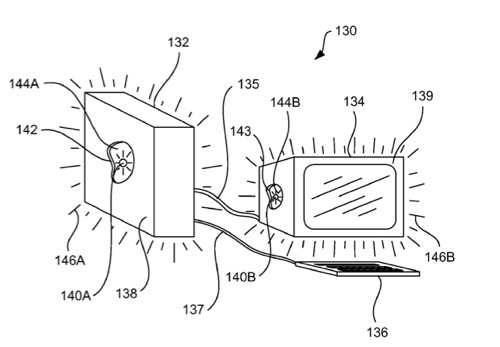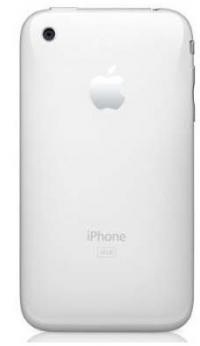An Apple patent (number 20100201539) for a computing device with an illuminable portion that can change the device’s appearance has popped up at the US Patent & Trademark Office.
The computing device also includes a light device disposed inside the housing. The light device is configured to illuminate the illuminable portion. The inventors are Duncan R. Kerr and Steve P. Hotelling.
Here’s Apple’s background and summary of the invention: “Most computing devices, including portable computers and desktop computers, give feedback to its user via a display screen or speakers. As is generally well known, display screens are used to display textual or graphical information to a user and speakers are used to output sound to the user. For example, display screens may be used to display a graphical user interface (GUI) and speakers may be used to output music or audio messages.
“Computing devices also give feedback to users via small indicators positioned on the computing device. By way of example, some indicators use light to indicate that a computing device (or the display screen of the computing device) is turned on/off or that a disk drive is reading or writing data to a disk. Although displays, speakers and indicators work well, they are limited to the type of feedback they give a user. For example, while playing a movie with a DVD drive of a computing device, the display screen only outputs the video associated with the movie, the speaker only outputs the audio associated with the movie, and the indicator only indicates that a movie is playing the DVD drive. Thus, it would be desirable to provide additional feedback to a user.
“Computing devices also have housings that enclose the components and circuitry associated with operating the computing devices. Housings generally serve to shield and protect the components and circuitry from adverse conditions such as impact and dust. In some cases, the housings are configured to surround all the components of the computing device while in other cases the housings are configured to surround individual or a subset of components. For example, a housing may be used to enclose the central processing unit (CPU), display screen, disk drive, and speaker to form a single unit. As another example, a plurality of different housings may be used to individually enclose the CPU, display screen, disk drive and speakers to form a plurality of individual units.
“As is generally well known, housings for computing devices in particular product lines are typically manufactured with the same appearance, i.e., they look the same. For example, housings from a particular product line may have the same box-like shape and/or the same neutral color. This can be discouraging to computer users who desire computers that are more personalized or to computer users who desire computers that are different than another user’s computer. Recently, manufacturers have attempted to remedy this problem by offering brightly colored or translucent housings for computing devices. For example, some computer and telephone manufacturers now sell a variety of housings, which have different colors and patterns. By way of example, the iMac computer, which is produced by Apple Inc. of Cupertino, Calif., is available in various colors and patterns.
“Although these recent advances make substantial inroads to overcoming the same old appearance, the housings for the computing device remain passive structures that exhibit a non-adaptable or non-changing appearance. That is, a colored or patterned housing has a single color or pattern associated therewith that does not change overtime.
“External lights have been used in some devices associated with displaying video to enhance the viewing experience of the video. Unfortunately, however, none of the external lights have been capable of changing the visual appearance of the device housing. That is, the external lights are typically located outside the periphery of the housing and are typically arranged to alter the environment in which the video is shown rather than the device housing itself (the appearance of the housing remains the same even with the use of lights). Thus, there is a need for improvements in appearances of housings for computing devices.
“The invention relates, in one embodiment, to a computing device. The computing device includes a housing for enclosing various internal components associated with the operation of the computing device. The computing device also includes an indicator assembly for indicating events associated with the computing device. The indicator assembly is configured to produce an indicator image at an outer surface of the housing when activated, and to eliminate the indicator image from the outer surface of the housing when deactivated.
“The invention relates, in another embodiment, to a housing indicator system. The housing indicator system includes a housing having at least an inner bezel. The inner bezel has a light receiving recess that forms a reduced thickness portion. The reduced thickness portion is translucent. The housing indicator system also includes a light source disposed behind the housing. The light source is configured to illuminate the reduced thickness portion in order to form an indicator image at the outer surface of the inner bezel. The shape of the recess produces an indicator image of similar shape on the outer surface of the inner bezel.
“The invention relates, in another embodiment, to a housing indicator system. The housing indicator system includes a housing having a clear outer layer and a translucent inner layer. The translucent inner layer includes a light receiving recess that forms a reduced thickness portion. The reduced thickness portion represents the area of the translucent layer that is illuminated. The housing indicator system also includes an indicator assembly. The indicator system includes a light device configured to provide light to the reduced thickness portion, a light barrier configured to prevent light from entering the translucent layer except at the reduced thickness portion and a light guide configured to direct light from the light source to the reduced thickness portion.
“The invention relates, in another embodiment, to a computer system. The computer system includes a processor configured to generate light control signals. The computer system also includes a light feature operatively coupled to the processor. The light feature includes one or more light emitting diodes capable of emitting light in order to illuminate an illuminable housing of the computer system. The computer system also includes a light driver disposed between the processor and at least one of the LEDs. The light driver is configured to convert the light control signals into a stable continuous current for driving the light emitting diode. The magnitude of the current is based at least in part on the light control signal. The magnitude of the current affects the light intensity of the light emitting diode.
“The invention relates, in another embodiment, to a method of illuminating a housing. The method includes generating a light control signal associated with a desired light intensity. The method also includes converting the light control signal into a voltage representative of the desired light intensity. The method further includes converting the voltage into a current representative of the desired light intensity. The current driving an LED so as to produce light. The method additionally includes directing the light from the LED through the housing such that an image is created at an outer surface of the housing.”



